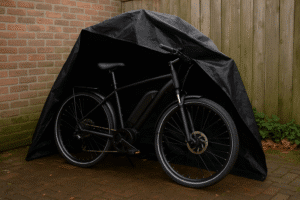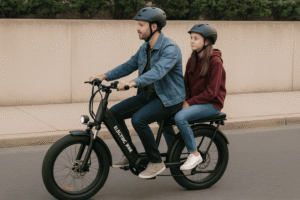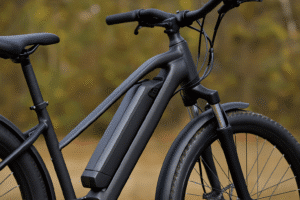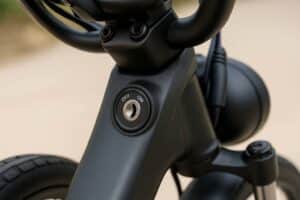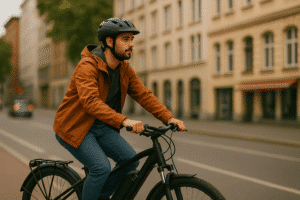Electric bikes and electric scooters have become two of the most popular ways to get around cities. Both are clean, quiet, and cheaper than driving a car.
But which one fits your daily routine better?
Let’s break down how they work, their pros and cons, and what to consider before buying one.
Key Summary:
- E-bikes offer better stability, longer range, and comfort for daily commuting or mixed terrain.
- E-scooters are cheaper, lighter, and easier to carry for short city rides.
- E-bikes are replacing car trips and provide health and environmental benefits.
- Scooters win on convenience and portability but fall short for long or rough rides.
Electric Bike vs Electric Scooter at a Glance
Here’s a quick comparison table to help you see how electric bikes and scooters stack up side by side.
| Feature | Electric Bike | Electric Scooter |
|---|---|---|
| Range | 40–100 km per charge | 15–40 km per charge |
| Top Speed | 20–28 mph, model dependent | 15–20 mph in most cities |
| Comfort | Seated ride, larger wheels, smoother on rough roads | Stand-up ride, small wheels, best on smooth pavement |
| Portability | Bulkier, some folding options | Light, foldable, easy to carry and store |
| Weight | ~50–70 lbs | ~25–40 lbs |
| Price | $1,200–$3,000+ | $400–$1,200 |
| Cargo Capacity | Racks, baskets, trailers, kid seats | Very limited, small hooks or bag only |
| Best For | Daily commuting, hills, mixed terrain, replacing car trips | Short city hops, last-mile rides, tight storage spaces |
| Maintenance | Bike shop friendly, regular tune-ups | Lower routine care, harder repairs if electronics fail |
| Charging Time | 3–6 hours typical | 3–5 hours typical |
| Safety & Stability | More stable at speed, better braking and traction | Stable at low speeds on smooth roads, less forgiving on bumps |
| Legal Basics | Class 1–3 rules may apply for paths and speed | Often limited to 15–20 mph and street or bike lane use |
What is an Electric Bike?
An electric bike (or e-bike) is a bicycle with a built-in electric motor that assists your pedaling. It helps you ride faster and farther with less effort.
E-bikes come in different classes. Class 1 provides pedal assist up to 20 mph, Class 2 includes a throttle for full motor power without pedaling, and Class 3 assists up to 28 mph.
You still need to pedal, but the motor makes hills and headwinds much easier to handle.
E-bikes are great for commuting, errands, or leisure rides. Most have a range of 40 to 100 km per charge and can carry heavier loads than scooters.
With their larger wheels and bicycle-style frames, they feel familiar to ride and are suitable for almost any terrain, from city streets to bike trails.
Pros and Cons of Electric Bikes
Electric bikes offer comfort and versatility, but they’re heavier and more expensive than scooters.
Pros of Electric Bikes:
- Travel farther on a single charge (typically 40–100 km)
- Handle hills and rough terrain with ease
- Can carry cargo, groceries, or even kids with racks or trailers
- Offer moderate exercise while still being motor-assisted
- Replace short car trips and save on fuel costs
Cons of Electric Bikes:
- More expensive upfront (usually $1,200–$3,000+)
- Heavier and harder to store in small spaces
- Require regular maintenance (tires, chains, gears)
- Slower to charge compared to scooters
- Theft risk is higher due to size and value
What is an Electric Scooter?
An electric scooter is a compact two-wheeled vehicle powered by an electric motor and battery. Riders stand on a platform and control speed with a throttle on the handlebar.
E-scooters are built for short, flat commutes. They can usually travel 15–40 km per charge and reach speeds of around 15–20 mph.
Because they’re small and foldable, you can easily carry them onto public transport or store them under a desk.
Electric scooters are often chosen for quick city trips, last-mile connections, or rides where portability matters most.
They don’t offer the comfort or range of an e-bike, but their convenience is hard to beat for urban travel.
Pros and Cons of Electric Scooters
E-scooters are compact and easy to use, though they have limits in comfort and distance.
Pros of Electric Scooters:
- Lightweight and foldable for easy storage or transport
- Lower upfront cost (many good options under $800)
- Simple “twist-and-go” control, no pedaling required
- Ideal for short, quick rides in urban areas
- Low maintenance compared to e-bikes
Cons of Electric Scooters:
- Shorter range and slower speeds
- Less stable on rough or uneven roads
- Not suitable for carrying cargo or passengers
- Harder to ride for long periods due to standing posture
- Limited weather protection; poor in rain or slippery surfaces
Electric Bike vs Electric Scooter: Key Differences
The main difference between an electric bike and an electric scooter is that e-bikes are designed for longer, more stable rides with the option to pedal, while scooters are smaller, lighter, and better suited for short, flat city trips.
E-bikes feel like bicycles with motor assistance, whereas scooters work like compact, stand-up vehicles powered entirely by a throttle.
Now let’s look closer at how they compare in comfort, range, speed, cost, portability, and maintenance.
Comfort and Riding Experience
Electric bikes provide a smoother and more stable ride, thanks to their larger wheels, suspension, and seated riding position.
You can pedal or use motor assist, which reduces fatigue on longer trips. This makes them ideal for commuting or weekend rides.
Electric scooters, by contrast, are stand-up vehicles with smaller tires. You feel every bump, and standing for long periods can get tiring.
Some higher-end scooters include suspension systems, but they still can’t match the comfort or control of an e-bike. If you value ride quality and balance, an e-bike wins easily here.
Speed and Range
E-bikes generally go farther and faster. A typical e-bike can reach 20–28 mph (32–45 km/h) depending on the class and assist level, while most scooters are limited to 15–20 mph (24–32 km/h) for safety reasons.
E-bikes also last longer per charge, 40 to 100 km, compared to 15 to 40 km for scooters.
Larger batteries, better aerodynamics, and the ability to pedal give e-bikes the advantage for distance riders and commuters who travel multiple miles daily.
Portability and Storage
Here, scooters clearly win. Most electric scooters fold down easily and weigh 25 to 40 pounds, making them perfect for carrying on buses, subways, or up apartment stairs.
You can even slide one under a desk at work.
Electric bikes, however, are heavier and bulkier, usually weighing 50 to 70 pounds. Even folding e-bike models are harder to lift and require more space.
For people with limited storage or who rely on public transport, scooters are far more convenient.
Cost and Value
Electric scooters are cheaper upfront, starting at around $400–$800 for reliable models. In contrast, most e-bikes start around $1,000 and can easily exceed $3,000 depending on features and build quality.
That said, e-bikes often justify the higher cost. They last longer, cover more distance, and can replace short car trips entirely, saving money on gas, parking, and maintenance.
If you commute daily or ride often, the investment pays off over time.
Maintenance and Repairs
Both e-bikes and scooters need care, but in different ways. E-bikes require routine bike maintenance, like checking chains, tires, and brakes, just like a regular bicycle.
The benefit is that any bike shop can service an e-bike, which keeps upkeep simple.
Scooters need less day-to-day maintenance, but when something breaks (like the motor or display), it’s often harder to fix locally.
You might need to ship it to the manufacturer for repair. Parts for scooters can also be harder to find, especially for smaller brands.
Safety and Stability
E-bikes are generally safer at higher speeds because they have larger tires, better braking systems, and balanced weight distribution. They handle uneven surfaces and sudden stops better.
Scooters, on the other hand, are more prone to tipping or slipping on rough terrain. Their smaller wheels make them less forgiving on cracks, potholes, or wet surfaces.
Still, scooters are quite safe at low speeds on smooth pavement when riders wear helmets and follow local laws.
Which Ride Fits Your Lifestyle Best?
Both electric bikes and scooters make daily travel easier and greener, but the right choice depends on your habits, distance, and comfort preferences. Here’s a quick way to decide.
Choose an e-bike if you:
- Commute longer distances (over 3–5 miles a day)
- Prefer a smoother, more stable ride on varied terrain
- Want to get light exercise while riding
- Need space for cargo, groceries, or an extra seat
- Plan to use it as a car alternative for errands or work
- Don’t mind spending more for better comfort and range
Choose an electric scooter if you:
- Live in a city and mostly travel short, flat routes
- Need something lightweight, foldable, and easy to carry
- Have limited storage at home or work
- Prefer a simple “hop on and go” style of riding
- Want a budget-friendly and low-maintenance option
Final Thoughts
Both e-bikes and e-scooters are changing how we move around cities.
E-bikes win when it comes to comfort, range, and versatility. They can handle long rides, hills, and heavier loads with ease.
Scooters shine in convenience, portability, and cost, making them perfect for quick city hops or last-mile commutes.
If you’re after a dependable daily ride that can replace car trips, go for an electric bike.
But if you want something compact, fun, and easy to carry, an electric scooter might just be the smarter pick. Either way, both help you save money, reduce emissions, and enjoy the freedom of electric travel.
Al Amin Morshed is the founder of BoltBikers and a seasoned e-bike reviewer with years of hands-on experience testing electric bikes. As a long-time e-bike enthusiast, he combines real-world riding insights with in-depth research to create honest, helpful content for riders of all levels. Through BoltBikers, Morshed aims to make e-biking more accessible, practical, and enjoyable – whether you’re a new rider or a daily commuter looking for the best gear.
